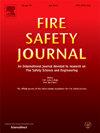A deep neural network approach for regional-scale 30-day accumulated urban fire occurrence forecast
IF 3.4
3区 工程技术
Q2 ENGINEERING, CIVIL
引用次数: 0
Abstract
Efforts to predict and mitigate urban fires require a comprehensive approach that accounts for the complex factors driving diverse fire occurrence patterns. Previous research on urban fire occurrence prediction models has been limited, particularly in addressing both spatial and temporal dynamics effectively. This study bridges this gap by developing a deep neural network (DNN) model specifically tailored to forecast a 30-day accumulated fire occurrence map with a resolution of 2.5 km × 2.5 km for the main urban area of Hangzhou, China. Utilizing a comprehensive 9-year dataset from 2015 to 2023, we develop a novel framework that integrates heterogeneous data, including meteorological factors, urban land use, and preceding daily fire occurrence maps. The framework not only forecasts fire occurrence maps but also provides valuable insights into how different urban land use categories contribute to the spatial patterns of fire occurrences. Our results demonstrate that the model effectively predicts the total count and spatial distribution of fire incidents. Additionally, investigations into urban land use vulnerability reveal that street and transportation zones are particularly susceptible. The proposed methodology addresses the critical need for short-term fire risk forecasting, offering an effective decision-support tool for local fire departments to implement fire risk mitigation strategies.
求助全文
约1分钟内获得全文
求助全文
来源期刊

Fire Safety Journal
工程技术-材料科学:综合
CiteScore
5.70
自引率
9.70%
发文量
153
审稿时长
60 days
期刊介绍:
Fire Safety Journal is the leading publication dealing with all aspects of fire safety engineering. Its scope is purposefully wide, as it is deemed important to encourage papers from all sources within this multidisciplinary subject, thus providing a forum for its further development as a distinct engineering discipline. This is an essential step towards gaining a status equal to that enjoyed by the other engineering disciplines.
 求助内容:
求助内容: 应助结果提醒方式:
应助结果提醒方式:


